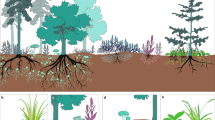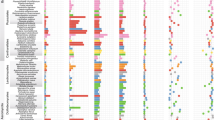Abstract
The symbiotic relationships between mycorrhizal fungi and plants have an enormous impact on terrestrial ecosystems1. Most common are the arbuscular mycorrhizas, formed by fungi belonging to the phylum Glomeromycota2. Arbuscular mycorrhizal fungi facilitate the uptake of soil nutrients by plants3 and in exchange obtain carbohydrates, thus representing a large sink4 for atmospheric plant-fixed CO2. However, how carbohydrates are transported through the symbiotic interface is still unknown. Here we report the characterization of the first known glomeromycotan monosaccharide transporter, GpMST1, by exploiting the unique symbiosis of a glomeromycotan fungus (Geosiphon pyriformis) with cyanobacteria5. The GpMST1 gene has a very low GC content and contains six introns with unusual boundaries. GpMST1 possesses twelve predicted transmembrane domains and functions as a proton co-transporter with highest affinity for glucose, then mannose, galactose and fructose. It belongs to an as yet uncharacterized phylogenetic monosaccharide transporter clade. This initial characterization of a new transporter family involved in fungal symbiosis will lead to a better understanding of carbon flows in terrestrial environments.
This is a preview of subscription content, access via your institution
Access options
Subscribe to this journal
Receive 51 print issues and online access
$199.00 per year
only $3.90 per issue
Buy this article
- Purchase on Springer Link
- Instant access to full article PDF
Prices may be subject to local taxes which are calculated during checkout



Similar content being viewed by others
References
Smith, S. E. & Read, D. J. Mycorrhizal Symbiosis (Academic Press, London, 1997)
Schüßler, A., Schwarzott, D. & Walker, C. A new fungal phylum, the Glomeromycota: phylogeny and evolution. Mycol. Res. 105, 1413–1421 (2001)
Marx, J. The roots of plant–microbe collaborations. Science 304, 234–236 (2004)
Bago, B. et al. Carbon export from arbuscular mycorrhizal roots involves the translocation of carbohydrate as well as lipid. Plant Physiol. 131, 1496–1507 (2003)
Schüßler, A. & Wolf, E. Geosiphon pyriformis—a glomeromycotan soil fungus forming endosymbiosis with cyanobacteria. In In vitro culture of mycorrhizas (Soil Biology, Volume 4) (eds Declerck, S., Strullu, D.-G., Fortin, J. A.) 271–289 (Springer, Berlin Heidelberg, 2005)
Schüßler, A. Molecular phylogeny, taxonomy, and evolution of Geosiphon pyriformis and arbuscular mycorrhizal fungi. Plant Soil 244, 75–83 (2002)
Wieczorke, R. et al. Concurrent knock-out of at least 20 transporter genes is required to block uptake of hexoses in Saccharomyces cerevisiae. FEBS Lett. 464, 123–128 (1999)
Sonnhammer, E. L. L., von Heijne, G. & Krogh, A. A hidden Markov model for predicting transmembrane helices in protein sequences. In Proceedings of the Sixth International Conference on Intelligent Systems for Molecular Biology (ISMB98) (ed. Glasgow, J., et al.) 175–182 (AAAI Press, Menlo Park, 1998)
Gould, G. W. & Seater, M. J. Introduction to the facilitative glucose transporter family. In Facilitative glucose transporters (Molecular Biology Intelligence Unit) (ed. Gould, G.W.) 1–38 (Springer, Berlin Heidelberg, 1997)
Lalonde, S., Wipf, D. & Frommer, W. B. Transport mechanisms for organic forms of carbon and nitrogen between source and sink. Annu. Rev. Plant Biol. 55, 341–372 (2004)
Sawaki, H. & Saito, M. Expressed genes in the extraradical hyphae of an arbuscular mycorrhizal fungus, Glomus intraradices, in the symbiotic phase. FEMS Microbiol. Lett. 195, 109–113 (2001)
Spingola, M., Grate, L., Haussler, D. & Ares, M. Jr. Genome-wide bioinformatic and molecular analysis of introns in Saccharomyces cerevisiae.. RNA 5, 221–234 (1999)
Hamacher, T., Becker, J., Gardonyi, M., Hahn-Hägerdal, B. & Boles, E. Characterization of the xylose-transporting properties of yeast hexose transporters and their influence on xylose utilization. Microbiology 148, 2783–2788 (2002)
van Kuyk, P. A. et al. Aspergillus niger mstA encodes a high-affinity sugar/H+ symporter which is regulated in response to extracellular pH. Biochem. J. 379, 375–383 (2004)
Meeks, J. C. et al. An overview of the genome of Nostoc punctiforme, a multicellular, symbiotic cyanobacterium. Photosynth. Res. 70, 85–106 (2001)
Knoblauch, M. Vergleichende physiologische Charakterisierung von Nostoc punctiforme und Nostoc muscorum im Hinblick auf die Symbiose von Nostoc in Geosiphon pyriforme. Master’s Thesis, 1–70, Univ. of Frankfurt. (1995)
Kluge, M., Mollenhauer, D. & Mollenhauer, R. Photosynthetic carbon assimilation in Geosiphon pyriforme (Kützing) F.v. Wettstein, an endosymbiotic association of fungus and cyanobacterium. Planta 185, 311–315 (1991)
Schüßler, A., Bonfante, P., Schnepf, E., Mollenhauer, D. & Kluge, M. Characterization of the Geosiphon pyriforme symbiosome by affinity techniques: confocal laser scanning microscopy (CLSM) and electron microscopy. Protoplasma 190, 53–67 (1996)
Solaiman, Z. & Saito, M. Use of sugars by intraradical hyphae of arbuscular mycorrhizal fungi revealed by radiorespirometry. New Phytol. 136, 533–538 (1997)
Bonfante, P. At the interface between mycorrhizal fungi and plants: the organization of cell wall, plasma membrane and cytoskeleton. In The Mycota IX—Fungal Associations (ed. Hock, B.) 45–61 (Springer, Berlin Heidelberg New York, 2001)
García, M., Sampedro, I., Ocampo, J. A. & García-Romera, I. Xyloglucanases in the interaction between Sinorhizobium meliloti, Rhizobium leguminosarum bv. viciae and Glomus mosseae. In Abstracts of the 5th International Conference on Mycorrhizas, 23–27 July 2006—Granada, Spain (eds Barea, J. M., Azcón, C., Gutiérrez, F., González, F., Molina, A. J.) 200 (Gráficas Zaidín, Granada, 2006)
Morales Vela, G., Molinero-Rosales, N., Algaba, N., Ocampo Bote, J. A. & García Garrido, J. M. Endocellulase activity in pea symbiotic mutants colonized by arbuscular mycorrhizal fungi. In Abstracts of the 5th International Conference on Mycorrhizas, 23–27 July 2006—Granada, Spain (eds Barea, J. M., Azcón, C., Gutiérrez, F., González, F., Molina, A. J.) 40 (Gráficas Zaidín, Granada, 2006)
Hildebrandt, U., Ouziad, F., Marner, F.-J. & Bothe, H. The bacterium Paenibacillus validus stimulates growth of the arbuscular mycorrhizal fungus Glomus intraradices up to the formation of fertile spores. FEMS Microbiol. Lett. 254, 258–267 (2006)
Wipf, D. et al. An expression cDNA library for suppression cloning in yeast mutants, complementation of a yeast his4 mutant and EST analysis from the symbiotic basidiomycete Hebeloma cylindrosporum. Genome 46, 177–181 (2003)
Gietz, D., St Jean, A., Woods, R. A. & Schiestl, R. H. Improved method for high efficiency transformation of intact yeast cells. Nucleic Acids Res. 20, 1425 (1992)
Acknowledgements
We thank E. Boles (University of Frankfurt) for providing EBY.VW4000 and CEN.PK2-1C yeast strains, D. Rentsch (University of Bern) for providing pDR196, and J. Gossmann (University of Frankfurt) for proofreading. This work was supported by grants from the Deutsche Forschungsgemeinschaft to D.C., H.M. and A.S. Author Contributions A.S., H.M. and D.C. isolated the full-length GpMST1 cDNA clones and performed semiquantitative RT–PCR. A.S. and D.C. retransformed EBY.VW4000, and performed screenings and growth tests. H.M. modified the pDR196 vector, constructed the cDNA libraries, and performed initial yeast transformations and screenings. M.F. performed the uptake assays. D.C. helped with uptake assays and performed gDNA amplification, PCR and clonings. A.S. made the phylogenetic analyses; A.S. and D.W. are responsible for the experimental design, hypotheses, interpreting the results and writing the manuscript.
Author information
Authors and Affiliations
Corresponding author
Ethics declarations
Competing interests
Sequences are deposited at EMBL Data Bank with the accession numbers AM231332 (GpMST1 cDNA clone pHM13-C6.1) and AM231333 (GpMST1 gDNA clone pDC-C6). Plasmids and clones are available on request. Reprints and permissions information is available at www.nature.com/reprints. The authors declare no competing financial interests.
Supplementary information
Supplementary Information
This file contains Supplementary Figures 1-3. Supplementary Figures 1 and 2 show phylogenetic analyses revealing the affiliation of GpMST1 to a clade containing sequences of yet uncharacterized putative fungal transporters. In Supplementary Figure 3, the intron-exon boundaries of GpMST1 are shown in comparison to consensus sequences from other organisms. (PDF 177 kb)
Rights and permissions
About this article
Cite this article
Schüßler, A., Martin, H., Cohen, D. et al. Characterization of a carbohydrate transporter from symbiotic glomeromycotan fungi. Nature 444, 933–936 (2006). https://doi.org/10.1038/nature05364
Received:
Accepted:
Issue Date:
DOI: https://doi.org/10.1038/nature05364
This article is cited by
-
RCO-3 and COL-26 form an external-to-internal module that regulates the dual-affinity glucose transport system in Neurospora crassa
Biotechnology for Biofuels (2021)
-
Serendipita indica changes host sugar and defense status in Arabidopsis thaliana: cooperation or exploitation?
Planta (2021)
-
The potential of arbuscular mycorrhizal fungi in C cycling: a review
Archives of Microbiology (2020)
-
To trade in the field: the molecular determinants of arbuscular mycorrhiza nutrient exchange
Chemical and Biological Technologies in Agriculture (2019)
Comments
By submitting a comment you agree to abide by our Terms and Community Guidelines. If you find something abusive or that does not comply with our terms or guidelines please flag it as inappropriate.



